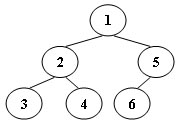An inorder binary tree traversal can be implemented in a non-recursive way with a stack. For example, suppose that when a 6-node binary tree (with the keys numbered from 1 to 6) is traversed, the stack operations are: push(1); push(2); push(3); pop(); pop(); push(4); pop(); pop(); push(5); push(6); pop(); pop(). Then a unique binary tree (shown in Figure 1) can be generated from this sequence of operations. Your task is to give the postorder traversal sequence of this tree.

Figure 1
Input Specification:
Each input file contains one test case. For each case, the first line contains a positive integer N (≤) which is the total number of nodes in a tree (and hence the nodes are numbered from 1 to N). Then 2 lines follow, each describes a stack operation in the format: "Push X" where X is the index of the node being pushed onto the stack; or "Pop" meaning to pop one node from the stack.
Output Specification:
For each test case, print the postorder traversal sequence of the corresponding tree in one line. A solution is guaranteed to exist. All the numbers must be separated by exactly one space, and there must be no extra space at the end of the line.
Sample Input:
6
Push 1
Push 2
Push 3
Pop
Pop
Push 4
Pop
Pop
Push 5
Push 6
Pop
Pop
Sample Output:
3 4 2 6 5 1#include<cstdio> #include<stack> #include<cstring> using namespace std; const int maxn = 35; struct Node{ int data; Node* lchild; Node* rchild; }; int n,pre[maxn],in[maxn],num = 0; Node* createTree(int preL,int preR,int inL,int inR){ if(preL > preR) return NULL; Node* root = new Node; root -> data = pre[preL]; //printf("%d ",root->data); int k; for(k = inL; k <= inR; k++){ if(in[k] == pre[preL]) break; } int numLeft = k - inL; root->lchild = createTree(preL+1,preL+numLeft,inL,k-1); root->rchild = createTree(preL+numLeft+1,preR,k+1,inR); return root; } void postOrder(Node* root){ if(root == NULL) return; postOrder(root->lchild); postOrder(root->rchild); printf("%d",root->data); num++; if(num < n) printf(" "); } int main(){ int x,k1=0,k2=0; scanf("%d",&n); stack<int> st; char str[5]; for(int i = 0; i < 2*n; i++){ scanf("%s",str); if(strcmp(str,"Push") == 0){ scanf("%d",&x); st.push(x); pre[k1++] = x; }else{ in[k2++] = st.top(); st.pop(); } } // printf("1 "); Node* root = createTree(0,n-1,0,n-1); // printf("2 "); postOrder(root); return 0; }